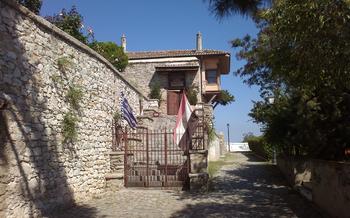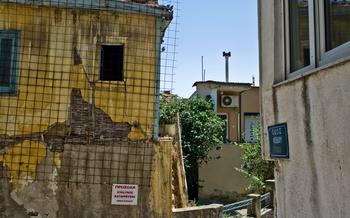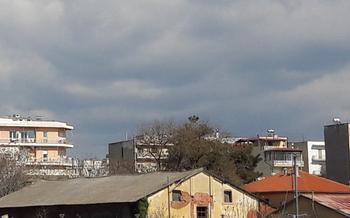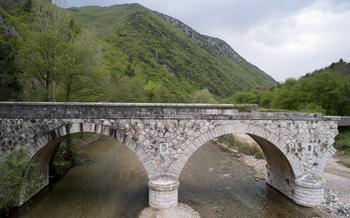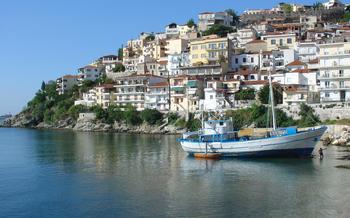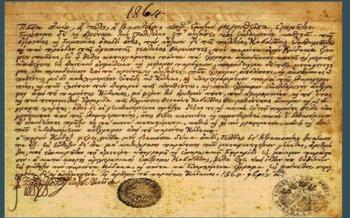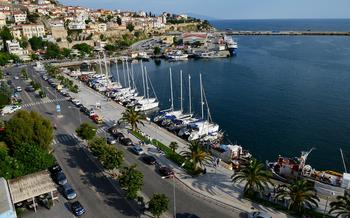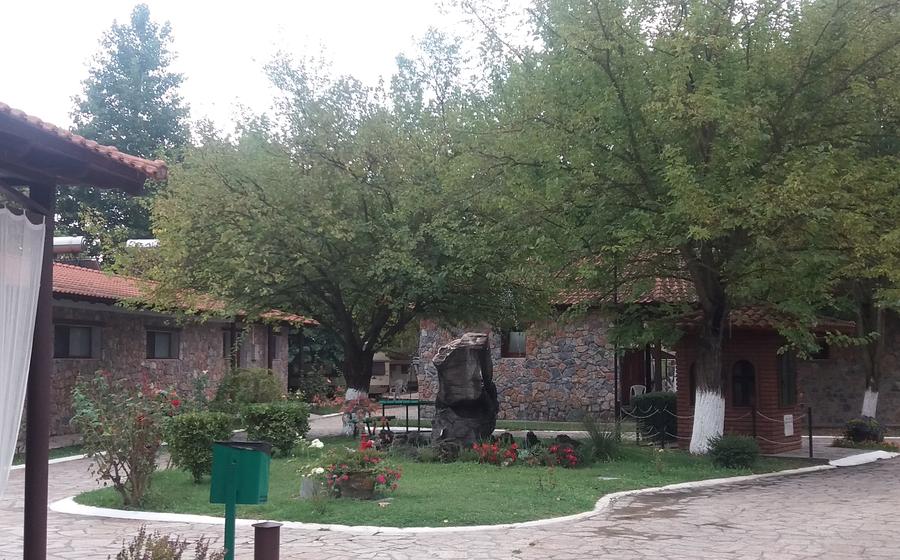
The Mud Baths of Krinides
- The Mud Baths of Krinides: A Unique Experience
- Location and Getting There
- Hours of Operation and Admission Fees
- What to Bring
- The Mud Bath Process
- Benefits of the Mud Baths
- Things to Do Nearby
- Where to Stay
- Where to Eat
- History of the Mud Baths
- Health Conditions Treated
- Contraindications
- Insider Tip
The Mud Baths of Krinides: A Unique Experience
The Mud Baths of Krinides, located in the picturesque region of Kavala, Greece, offer a unique and rejuvenating experience for visitors seeking relaxation and holistic wellness. Immerse yourself in the therapeutic properties of the mud, naturally enriched with minerals and trace elements, which have been revered for centuries for their healing powers. Whether you're looking to soothe skin conditions, alleviate joint pain, or simply unwind and de-stress, the Mud Baths of Krinides provide a sanctuary for both body and mind. Let's delve into the history, benefits, and practicalities of this remarkable destination.
Location and Getting There
The Mud Baths of Krinides are located in the village of Krinides, approximately 15 kilometers east of Kavala, in the region of Eastern Macedonia and Thrace. The village is situated in a picturesque valley, surrounded by lush greenery and rolling hills. The mud baths are easily accessible by car, public transportation, or taxi.
To get to the mud baths from Kavala, you can take the Egnatia Odos highway and exit at Krinides. The mud baths are well-signposted from the exit. Alternatively, you can take a bus or taxi from Kavala to Krinides. Buses depart from the Kavala bus station and take approximately 30 minutes to reach Krinides. Taxis are readily available at the Kavala port and train station.
Hours of Operation and Admission Fees
The Mud Baths of Krinides are open to the public daily from 8:00 am to 8:00 pm, with the last admission at 7:00 pm. Admission fees are very reasonable, at only 5 euros for adults and 3 euros for children under Family discounts are available, and there is no extra charge for private sessions.
You can book a private session in advance by calling the mud baths directly. This is a great option if you want to avoid the crowds or have specific needs or concerns.
What to Bring
To make the most of your experience at the mud baths, it is important to come prepared. Here are a few essential items to bring with you:
-
Swimsuit and towel: You will need a swimsuit to wear in the mud bath and a towel to dry off afterwards.
-
Flip-flops or water shoes: The floors of the mud baths can be slippery, so it is a good idea to wear flip-flops or water shoes to protect your feet.
-
Sunscreen: Even though you will be spending most of your time in the mud, it is still important to protect your skin from the sun. Apply sunscreen to all exposed areas of your skin before and after your mud bath.
-
Water bottle: It is important to stay hydrated, especially when you are sweating in the mud bath. Bring a water bottle with you to stay hydrated throughout your visit.
The Mud Bath Process
The mud bath process is simple and straightforward. First, you will need to apply the mud to your skin. You can do this by using your hands or a brush. Be sure to cover your entire body, except for your face. Once the mud is applied, you will need to leave it on for about 15-20 minutes. During this time, you can relax and let the mud work its magic. After 15-20 minutes, you can rinse off the mud with warm water. You can do this in the shower or in the nearby sea. Once you have rinsed off the mud, be sure to apply moisturizer to your skin to keep it hydrated.
Benefits of the Mud Baths
The mud baths of Krinides are renowned for their therapeutic properties, which have been recognized for centuries. The mud is rich in minerals, including sulfur, magnesium, and calcium, which are essential for healthy skin and joints.
Skin care: The mud is a natural exfoliator that helps to remove dead skin cells and improve circulation. It also helps to reduce inflammation and soothe skin conditions such as eczema and psoriasis.
Joint pain relief: The minerals in the mud help to reduce inflammation and pain in the joints. Mud baths can be especially beneficial for people with arthritis or other joint pain conditions.
Stress relief: The warm, soothing mud and the tranquil setting of the baths can help to reduce stress and promote relaxation. Mud baths can be a great way to unwind and de-stress.
Detoxification: The mud is believed to help to draw toxins out of the body, promoting detoxification. Mud baths can be helpful for people who are looking to improve their overall health and well-being.
Things to Do Nearby
In addition to enjoying the therapeutic benefits of the mud baths, there are several other things you can do in the surrounding area to make your visit even more memorable. History buffs will appreciate a visit to the Krinides Archaeological Museum, which houses a collection of artifacts from the region's rich past. Nature lovers can explore the Krinides Forest, a beautiful natural area with hiking trails and picnic spots. And if you're looking to cool off after your mud bath, head to the nearby beach for a refreshing swim.
Where to Stay
If you're planning to spend a few days in Krinides to make the most of the mud baths and explore the surrounding area, there are several accommodation options to choose from.
-
Hotels and Resorts: For a comfortable and luxurious stay, you can choose from several hotels and resorts in Krinides. These typically offer a range of amenities such as swimming pools, spas, and restaurants.
-
Airbnb and Vacation Rentals: If you prefer a more homey experience, there are many Airbnb and vacation rentals available in Krinides. These offer a variety of options, from cozy apartments to spacious villas, and often come with kitchens and other amenities.
-
Camping Options: For those who love the outdoors, there are several camping sites in and around Krinides. These offer a more rustic experience and allow you to immerse yourself in the natural beauty of the area.
Where to Eat
After a relaxing mud bath, you'll likely be feeling hungry. Luckily, there are several dining options near the mud baths to satisfy your appetite.
-
Restaurants in Krinides: Krinides has a variety of restaurants serving traditional Greek cuisine, seafood, and international dishes. Some popular restaurants include To Kyma, To Steki tou Ilia, and To Elliniko.
-
Tavernas and cafes: For a more casual dining experience, try one of the many tavernas or cafes in Krinides. These establishments typically serve simple, home-cooked meals and snacks, as well as local wines and beers.
-
Street food vendors: If you're on a budget or just looking for a quick bite, there are several street food vendors in Krinides selling everything from souvlaki to gyros to fresh fruit.
History of the Mud Baths
The mud baths of Krinides have a long and rich history, dating back to ancient times. The mud's therapeutic properties were first discovered by the Thracians, who inhabited the region in the 5th century BC. The Thracians used the mud to treat a variety of ailments, including skin diseases, joint pain, and stress.
In the 16th century, the mud baths were rediscovered by the Ottoman Turks, who ruled the region for over 500 years. The Turks built several bathhouses around the mud springs, and the baths quickly became a popular destination for people from all over the Ottoman Empire.
In the 19th century, the mud baths were visited by a number of European travelers, who wrote about their experiences in their travelogues. These accounts helped to spread the word about the mud baths, and soon people from all over the world were coming to Krinides to experience the healing powers of the mud.
Health Conditions Treated
The therapeutic properties of the mud at the Krinides Mud Baths make it an effective treatment for a variety of health conditions, including:
-
Skin disorders: The mud's anti-inflammatory and antibacterial properties can help to soothe and heal a variety of skin conditions, including eczema, psoriasis, and acne.
-
Musculoskeletal disorders: The mud's heat and buoyancy can help to relieve pain and stiffness in the joints and muscles, making it an effective treatment for conditions such as arthritis, back pain, and fibromyalgia.
-
Stress-related conditions: The mud's calming and relaxing effects can help to reduce stress and anxiety, and improve mood. This can be beneficial for people with conditions such as depression, insomnia, and chronic fatigue syndrome.
Contraindications
Not everyone is suitable for mud baths. Certain health conditions may make mud baths inadvisable or even dangerous. It is important to consult with a doctor before indulging in mud therapy if you have any of the following conditions:
-
Pregnancy: Mud baths can cause uterine contractions, which can be harmful to the fetus.
-
Open wounds or skin infections: Mud can harbor bacteria that can cause infections. Open wounds or skin infections should be allowed to heal completely before taking a mud bath.
-
Severe heart conditions or respiratory problems: The heat and humidity of mud baths can put a strain on the heart and lungs. People with severe heart conditions or respiratory problems should avoid mud baths.
Insider Tip
To make the most of your visit to the mud baths, consider combining it with a trip to the nearby hot springs. Located just a few kilometers away, the hot springs offer a unique and rejuvenating experience. Immerse yourself in the warm, mineral-rich waters and let your worries melt away. The combination of the mud baths and hot springs will leave you feeling refreshed, relaxed, and revitalized.
